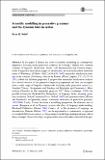Scientific modelling in generative grammar and the dynamic turn in syntax
Abstract
In this paper, I address the issue of scientific modelling in contemporary linguistics, focusing on the generative tradition. In so doing, I identify two common varieties of linguistic idealisation, which I call determination and isolation respectively. I argue that these distinct types of idealisation can both be described within the remit of Weisberg’s (J Philos 104(12):639–659, 2007) minimalist idealisation strategy in the sciences. Following a line set by Blutner (Theor Linguist, 37(1–2):27–35, 2011) (albeit for different purposes), I propose this minimalist idealisation analysis for a broad construal of the generative linguistic programme and thus cite examples from a wide range of linguistic frameworks including early generative syntax (i.e. Standard Theory, Government and Binding and Principles and Parameters), Minimalism (Chomsky in The minimalist program, MIT Press, Cambridge, 1995), the parallel architecture (Jackendoff in Foundations of language: brain, meaning, grammar, evolution, Oxford University Press, Oxford, 2002) and optimality theory (Prince and Smolensky in Optimality theory: constraint interaction in generative grammar, 1993/2004). Lastly, I claim that from a modelling perspective, the dynamic turn in syntax (Kempson et al. in Dynamic syntax—the flow of language understanding, Blackwell Publishers, Oxford, 2001; Cann et al. in The dynamics of language: an introduction, Elsevier, Oxford, 2005) can be explained as a continuation, as opposed to a marked shift (or revolution), of the generative modelling paradigm (despite radical theory change). Seen in this light, my proposal is an even broader construal of the generative tradition, along scientific modelling lines. Thus, I offer a lens through which to appreciate the scientific contribution of generative grammar, amid an increased resistance to some of its core theoretical posits, in terms of a brand of structural realism in the philosophy of science and specifically scientific modelling.
Citation
Nefdt , R M 2016 , ' Scientific modelling in generative grammar and the dynamic turn in syntax ' , Linguistics and Philosophy , vol. 39 , no. 5 , pp. 357-394 . https://doi.org/10.1007/s10988-016-9193-4
Publication
Linguistics and Philosophy
Status
Peer reviewed
ISSN
0165-0157Type
Journal article
Collections
Items in the St Andrews Research Repository are protected by copyright, with all rights reserved, unless otherwise indicated.

